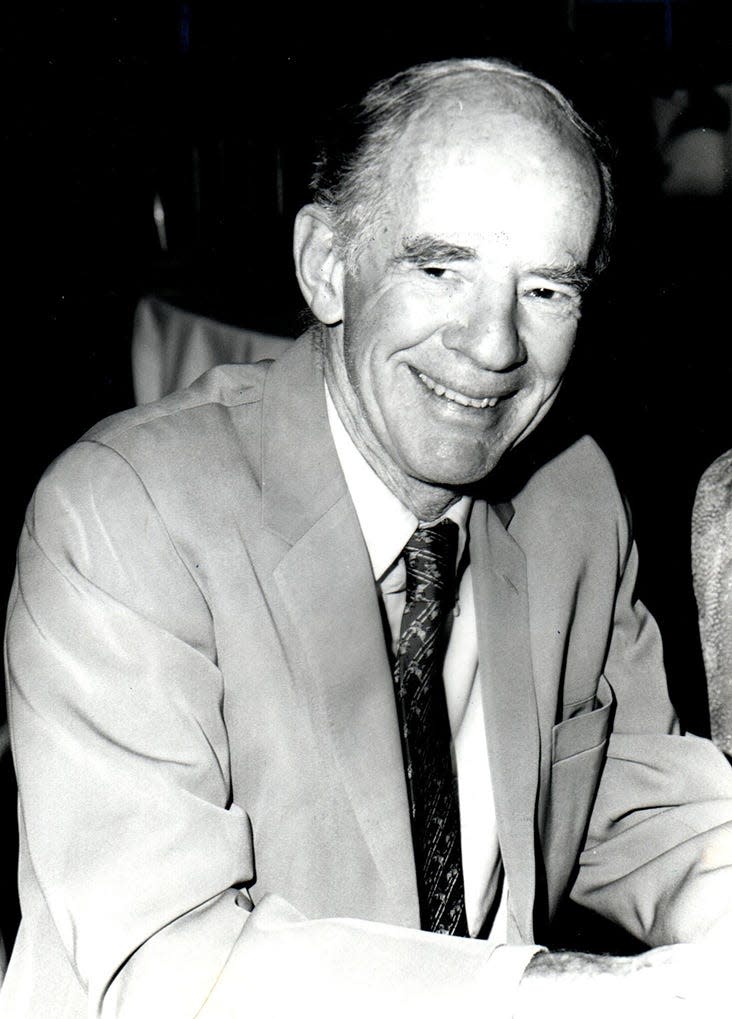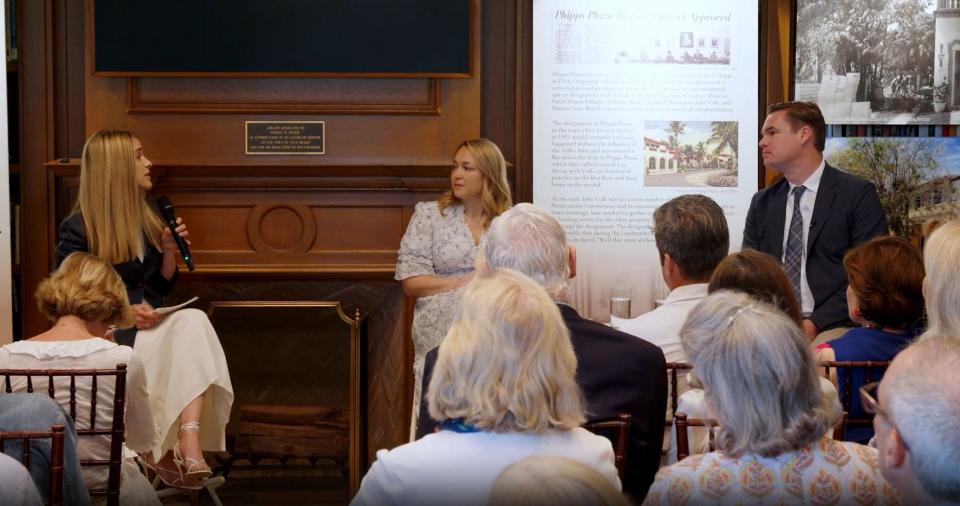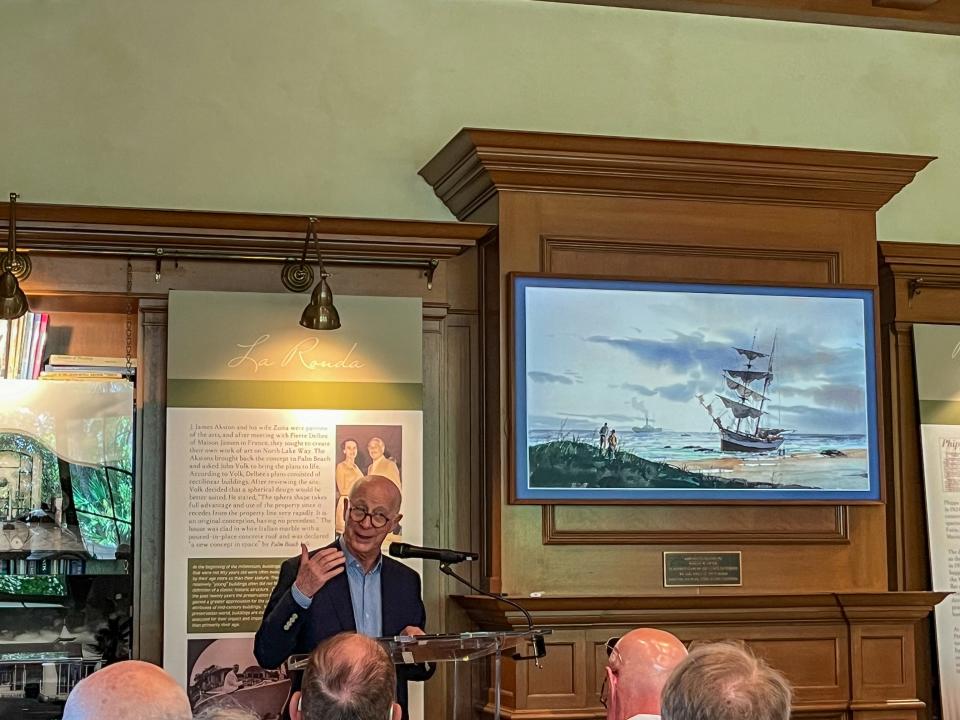Symposium cites 1970s parallels to current development pressures in Palm Beach
- Oops!Something went wrong.Please try again later.
The redevelopment pressures Palm Beach currently faces parallel those faced by the town in the 1970s during the tenure of late Town Council member Robert M. Grace, who helped create the town's current zoning code.
That was the central theme in a panel discussion that kicked off the Preservation Foundation of Palm Beach's inaugural biennial Robert M. Grace Leadership Symposium last week.
"Those discussions are hyper-relevant, because we are all feeling the pressures of development intensity at a high level once again," panelist and Town Council member Ted Cooney said about Grace's memos discussing the development pressures of the 1970s.

Grace, who served on the council from 1970 to 1984, was a key player in the drafting and adoption of the zoning code in 1974, said Preservation Foundation CEO and President Amanda Skier during the March 28 event. Skier also noted his lead in creating Palm Beach's two powerful design boards, the Architectural Commission and the Landmarks Preservation Commission.
Grace, a high school economics teacher, also went on to help found the Preservation Foundation in 1980.
According to a documentary presented at the event, Grace took the lead in limiting development and ensuring a zoning code that prioritized open space, green space and the town's peculiarities. Aimee Sunny, a panelist and the foundation's director of preservation and planning, said Grace's memos emphasized the special characteristics of the town.
"When he's talking about open space and green space, he was very cognizant of the differences in town," said Sunny. "You know, Worth Avenue (in Midtown) is not the same as the North End, (which) is not the same as the South End."
Cooney agreed, highlighting Grace's unsuccessful push to regulate the space between a building and a street, known as a setback, by considering the average setbacks of surrounding properties.

Skier, who moderated the panel, asked if the zoning code's parking requirements were an effective measure for controlling development.
"I don't know a much better metric at the moment," Cooney said, noting that balancing open space and parking is still a major challenge.
Asked if the zoning code continues to follow Grace's guidance, Cooney said he believed it does, although he added that it had expanded to the point of undermining ease of use. "So there's a lot of those (changes) that make it challenging, and somewhat contradictory in certain elements," said Cooney.
Sunny agreed, noting the challenge with crafting a zoning code is its attempt to deal with "all situations at all times." This is why variances are important, she said, noting the multiple landmarked and historic buildings that do not conform to the code.
Both panelists highlighted the importance of the landmarks and architecture boards in arbitrating which variances are genuine hardships created by the inherent gaps in the code.
Pulitzer-winning architecture critic says preservation involves embracing change
After the panel discussion, renowned architecture critic, journalist and educator Paul Goldberger discussed the relationship between progress and preservation after the panel's discussion.
"However much people may think the Preservation Foundation is trying to stop the pace of change, what you are really doing is managing change, to keep the character of the city," said the Pulitzer Prize-winning writer, "and to make it continue to work in a world that will change whether or not we want it to."
He said preservation in Palm Beach is better thought of as the preservation of the "idea" that defines the town, rather than the preservation of individual buildings.

But this does not mean continuing to build in the same architectural style —namely, he said, the Addison Mizner-inspired Spanish Revival, he said. While it's fine to continue developing structures in that style, it's not the only style that defines the town, Goldberger said, noting famed Palm Beach architect John Volk's adoption of both Bermudian- and modern-style architecture.
"The challenge is in knowing what change is positive, and what change is destructive," he said.
Even if overdevelopment in Palm Beach were successfully halted, doing would would come with the risk of forcing out families with deep roots in the community because of skyrocketing land prices, Goldberger said. "I don't have an easy answer for this," he said. "But I do know that a place that does not have a range of types of people and a range of incomes is a place that loses people who have roots in it ... (and) is diminished as a community."
According to Goldberger, that's where the surrounding communities, including West Palm Beach, play a key role as a pressure valve, diffusing development pressure away from the island, while also providing a new home to those forced to move out of Palm Beach. "My point is that Palm Beach is really more connected to its surrounding (area) than its physical form as an island would suggest," he said. "It couldn't really exist on its own."
Goldberger also briefly highlighted two future development projects currently at the center of town discussion — the Paramount Building redevelopment project and the Frisbie Group's proposal to redevelop the 5.8-acre property, owned by Wells Fargo Bank into a low-density residential neighborhood at the northeast corner of South County Road and Royal Palm Way.
He said these projects capture the multi-faceted challenge faced by preservationists. They must not only preserve historic architecture, he said, but also recognize when it may need to be changed or adapted to the current situation.
"There are no formulas for that," Goldberger said. "Every building is different in terms of what it represents and how easily adaptable it is. And every proposal is different, both in terms of what it adds and what it takes away from the value of the original architecture."
Diego Diaz Lasa is a journalist at the Palm Beach Daily News, part of the USA TODAY Florida Network. You can reach him at dlasa@pbdailynews.com. Help support our journalism. Subscribe today.
This article originally appeared on Palm Beach Daily News: Palm Beach forum cites '70s parallels to current development pressures

